Myanmar’s junta tightened its stranglehold on the country Monday, occupying hospitals and schools and shutting down five independent news outlets amid ongoing violence against peaceful protesters across the country that left at least four people dead and many others injured, witnesses said.
Soldiers began occupying public universities, hospitals, and religious building nationwide on Sunday, angering the public and adding impetus to protests that have raged since the military deposed the elected civilian government on Feb. 1.
Five local independent news outlets — Mizzima, Democratic Voice of Burma (DVB), 7Day News, Myanmar Now, and Khit Thit news — have been banned from broadcasting, publishing, and posting news online, the junta-run Myawaddy TV news announced Monday, five weeks after the army deposed Aung San Suu Kyi’s civilian government.
Anti-regime demonstrators met with more violent crackdowns on Monday, when at least four people died and many were injured, including three in Myitkyina, capital of Kachin state, and one in Ayeyarwady region, where authorities arrested about 70 protesters.
Security forces used tear gas and live rounds against protesters in Myitkyina’s Aung Nan ward, leaving two dead and seriously wounding two others. Several people were injured by rubber bullets fired at the crowd, and at least 50 others were arrested.
Police also made some arrests when they broke up a women’s protest column commemorating International Women’s Day.
Security forces are occupying at least 20 government universities, schools, and hospitals in major cities, including Yangon, Mandalay, Magway, Monywa, and using them as base camps, the online journal The Irrawaddy reported.
Local residents in several cities throughout the country have objected to the setting up of bases by police and soldiers in hospitals, schools, and religious buildings.
In the central Magway region, two people were injured and four were arrested Sunday night when police broke up protesters who demanded that security forces leave the campus of Yenangyaung University.
“We saw troops establishing a base in our university, and we went there to protest their presence,” said one student. “Police soon arrived there along with prison vans. We were just having a peaceful protest, but they started firing shots into the air.”
As the students fled the scene, some soldiers fired tear gas at them, hitting a chemistry student on the thigh with a rubber bullet, while another protester also hit by a rubber bullet fell unconscious, he said.
Police arrested four protesters, while several other students went into hiding, witnesses said.
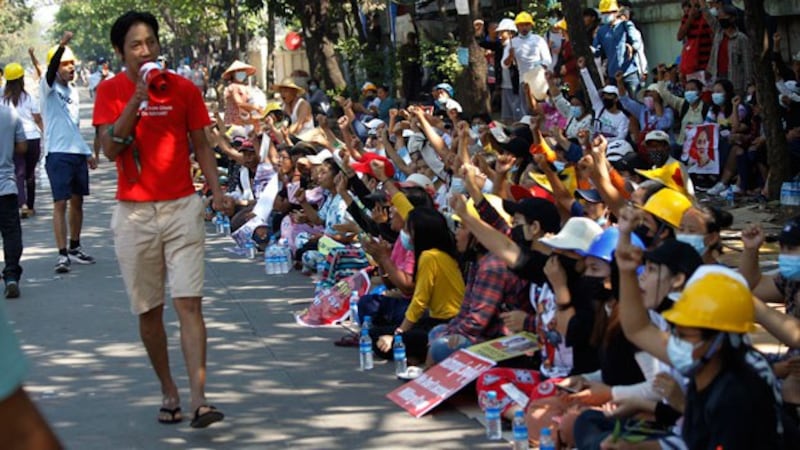
Soldiers occupy, hospital, university
Soldiers have occupied civilian hospitals in Tedim and Falam in western Chin state, as well as a university campus in Hakha since last night, locals said.
“About five soldiers are now at Falam's civilian hospital, and they said it’s for the security of the hospital,” said one resident who declined to be identified. “Actually, there is nothing to worry about in terms of security, and we don't need the military to take charge. People are even feeling more insecure because of their presence.”
People who do not require emergency care are being sent to free clinics manned by health care workers participating in the civil disobedience movement, the resident said.
The commanding officer of the 20 troops occupying the hospital and university told the school’s rector that that the soldiers were establishing a base for the security of the area under orders from the Chin state military council, locals said.
Police and soldiers also set up bases at East Yangon General Hospital, West Yangon General Hospital, Yangon General Hospital, Waibargi Hospital, Central Women’s Hospital, and South Okkalapa Women and Children’s Hospital, local residents said.
When a police patrol car arrived at Waibargi Hospital at about 5 p.m., neighborhood residents banged pots and pans in protest, said an area resident.
After the people dispersed at around 8 p.m. to heed a dusk-to-dawn curfew, about 10 military trucks arrived and fired roughly 20 stun grenades, he said.
“Several people were wounded, and some doctors who had joined the civil disobedience movement gave necessary treatment in homes because ambulances were not available,” the resident said.
A resident of Yangon’s Kyimyindaing township posted videos that showed police shooting at random during the night in the compound of West Yangon General Hospital.
Political analyst Than Soe Naing said security forces now are taking over strategic spots such as schools and hospitals as a measure to reduce the protest rallies.
“It’s a part of their strategy, though people can still go to protest marches without first gathering at a rallying point as they are determined to continue their fight,” he told RFA. “The police now have to spread their forces out in many places, though they will have more difficulties.”
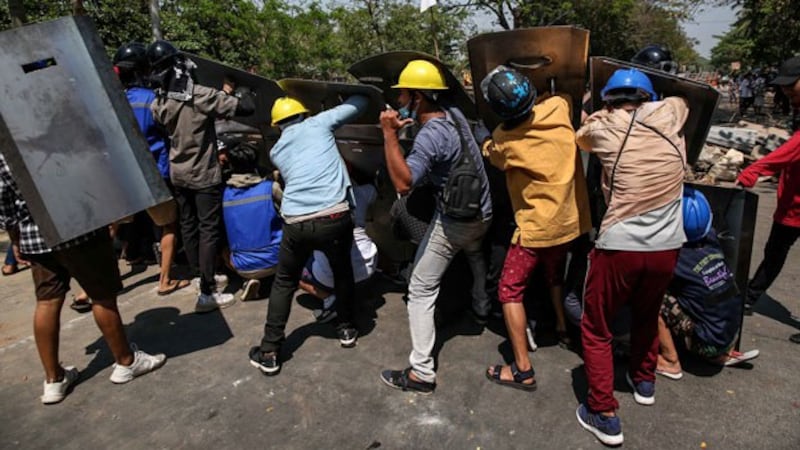
Neighborhood scare tactics
Police and soldiers also have resorted to using scare tactics by going into residential areas at night, firing their guns, and making arrests.
“We are furious. We are not scared. We are going to fight on,” said a resident of North Okkalapa township in Yangon. “Older residents might be scared and feel threatened, but not us.”
On Sunday, security forces fired their weapons at the corner of a road in a residential area, scaring senior citizens with the sound of loud gunfire, she said.
“Older folks were frightened and turned off their lights, hiding in the dark,” she said.
On Monday, New York-based Physicians for Human Rights (PHR) condemned the occupation of hospitals by the Myanmar military.
“If anything, the Myanmar military appears to be emboldened and is expanding its abusive tactics to hospitals and additional residential areas,” said Raha Wala, PHR’s advocacy director, in a statement.
“Hospitals and clinics should always be protected, safe for staff and patients alike, and the medical care of patients should never be impeded,” he said. “This is an urgent emergency situation that must be treated as such by the international community.”
PHR noted that under international human rights law, states are obligated to ensure effective protection for health workers at all times and to provide unencumbered access to emergency health care for all, regardless of a state of emergency.
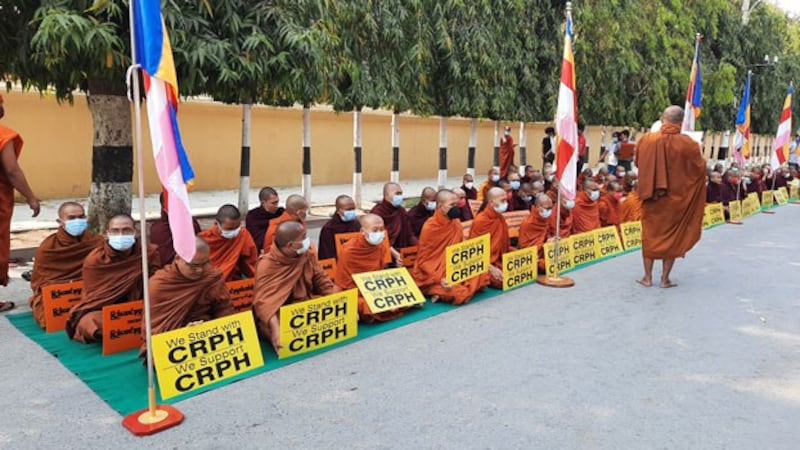
At least 57 dead
There have been at least 57 deaths in Myanmar since the beginning of the coup on Feb. 1, according to an RFA tally.
The Assistance Association for Political Prisoners (AAPP), a watchdog group, said that as of Monday, 1,857 people had been arrested, charged, or sentenced in relation to the military coup, with 1,538 still being held.
In Pyapon, Ayeyarwady region, one man died and seven others were injured in a violent crackdown, witnesses said. About 70 protesters were arrested.
“Police and soldiers fired some shots into the air to disperse the crowds, and our student column came back calling for the release of those arrested,” said a student protester. “They used tear gas, stun grenades, and live ammunition against us. One died, and seven others were wounded.”
In the town of Einme, Ayeyarwady region, one protester was injured by gunfire, and police made nine arrests when officers together with reinforcements from Myaungmya broke up a protest march comprising an ethnic Karen youth column, a women’s column, and a people’s column.
In several other regions and states across the country, authorities detained dozens of protesters, and witnesses said police fired shots at peaceful protesters without initial warnings.
In Yangon, military and police forces broke into the offices of Myanmar Now news agency and the 88 Generation Peace and Open Society group, where they confiscated computers, a safe, paintings, and official documents from the later location.
“Police and soldiers broke down the doors of the Myanmar Now newspaper building in Yangon and took away computers and some office equipment,” chief editor Swe Win told RFA.
In Yangon’s Tamwe township, women held an anti-military protest march holding their sarongs as flags to commemorate International Women’s Day. No arrests were made.
Security forces also began locking down protesters in Yangon’s Sanchaung township on Monday evening. Demonstrators were blocked by the forces from both sides of the main roads, where city residents began gathering to rally against the action.
Social media footage recorded by people at the scene shows shooting along with screaming and shouting, as security forces blocked protesters. Some demonstrators sheltered in residents’ homes, through police and soldiers tried to enter the houses to arrest them.
RFA was not able to obtain the number of injuries or arrests during the action.
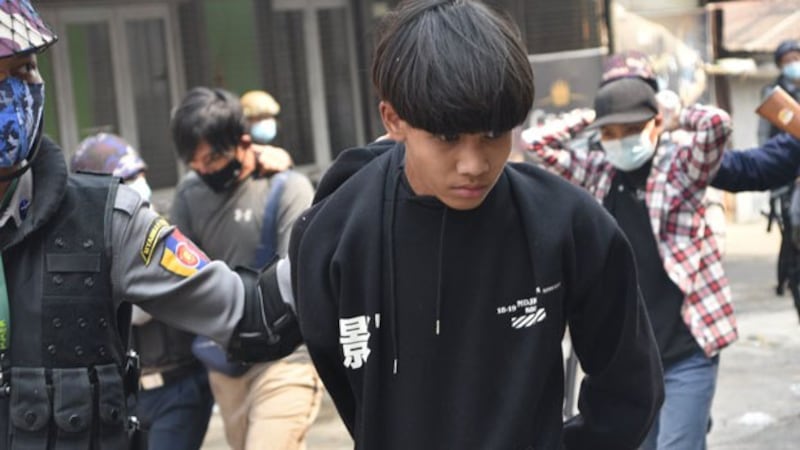
US, UN call out military
The move prompted swift responses from the U.S. Embassy in Yangon and the and United Nations on social media
“There is heightened tension caused by security forces surrounding Kyun Taw Road in Sanchaung township, Yangon,” the embassy tweeted. “We call on those security forces to withdraw and allow people to go home safely.”
The U.N. in Myanmar called for an immediate de-escalation of the situation and for security forces to let protestors return home safely, while the international body’s human rights office (OHCHR) tweeted that it was concerned about the protesters in Sanchaung.
“We are deeply concerned about the fate of some 200 peaceful protestors — incl. women — who have been cordoned by security forces in Yangon, and may be at risk of arrest or ill-treatment. We urge the police to immediately allow them to leave safely and without reprisals,” OHCHR said.
Yanghee Lee, former U.N. rapporteur on human rights in Myanmar, also denounced security forces that surrounded civilians in Sanchaung and reports of gunshots.
“This is unacceptable,” she tweeted. “Security forces must allow safe passage & retreat from the area. Stop stoking fear in people including children.”
Security forces detained several protesters and injured others in Yenangyaung of Mandalay region and in Falam and Hakha of Chin state.
People continued anti-junta rallies in Mandalay, Myanmar’s second-largest city, despite police crackdowns. Two men were seriously injured when a military truck crashed into their motorcycles between 56th and 57th Streets.
The incident followed another protest there on Sunday when police arrested more than 90 protesters.
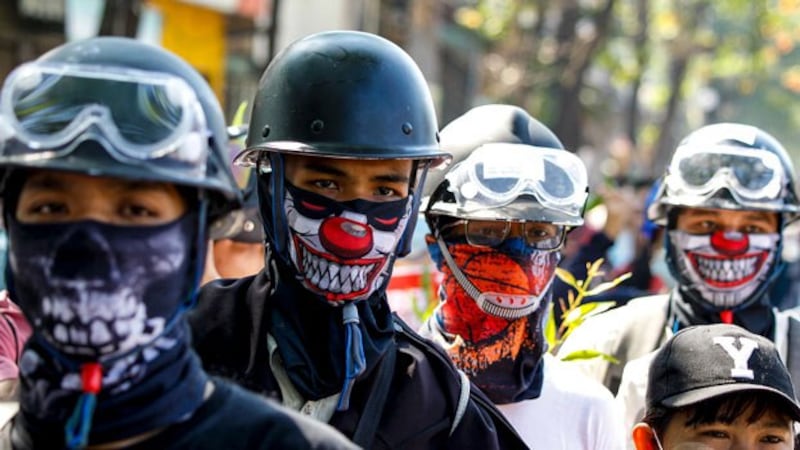
Rallies in other major cities
In Naypyidaw, nearly 200 people held a rally in front of the Pyinmana sugar mill, but security forces dispersed the crowd 30 minutes later.
Anti-military protest marches also continued in Kawkareik, Kayin state, and in several towns in Mon state.
In the town of Thaton, Karen National Union troops helped protesters continue their march without incident. In Hpa-an, Kayin’s capital, police blocked all the intersections and main roads. No protest marches were reported there.
In Dawei, Tanintharyi region, several protesters were injured and at least 10 arrested when police violently cracked down on demonstrators.
Police and soldiers in Lashio, northern Shan state, broke up a protest march and arrested six people. Near the border town of Muse, police and soldiers used tear gas, stun grenades, and rubber bullets to disperse protesters. One man was injured, witnesses said.
Reported by RFA’s Myanmar Service. Translated by Khin Maung Nyane. Written in English by Roseanne Gerin.
